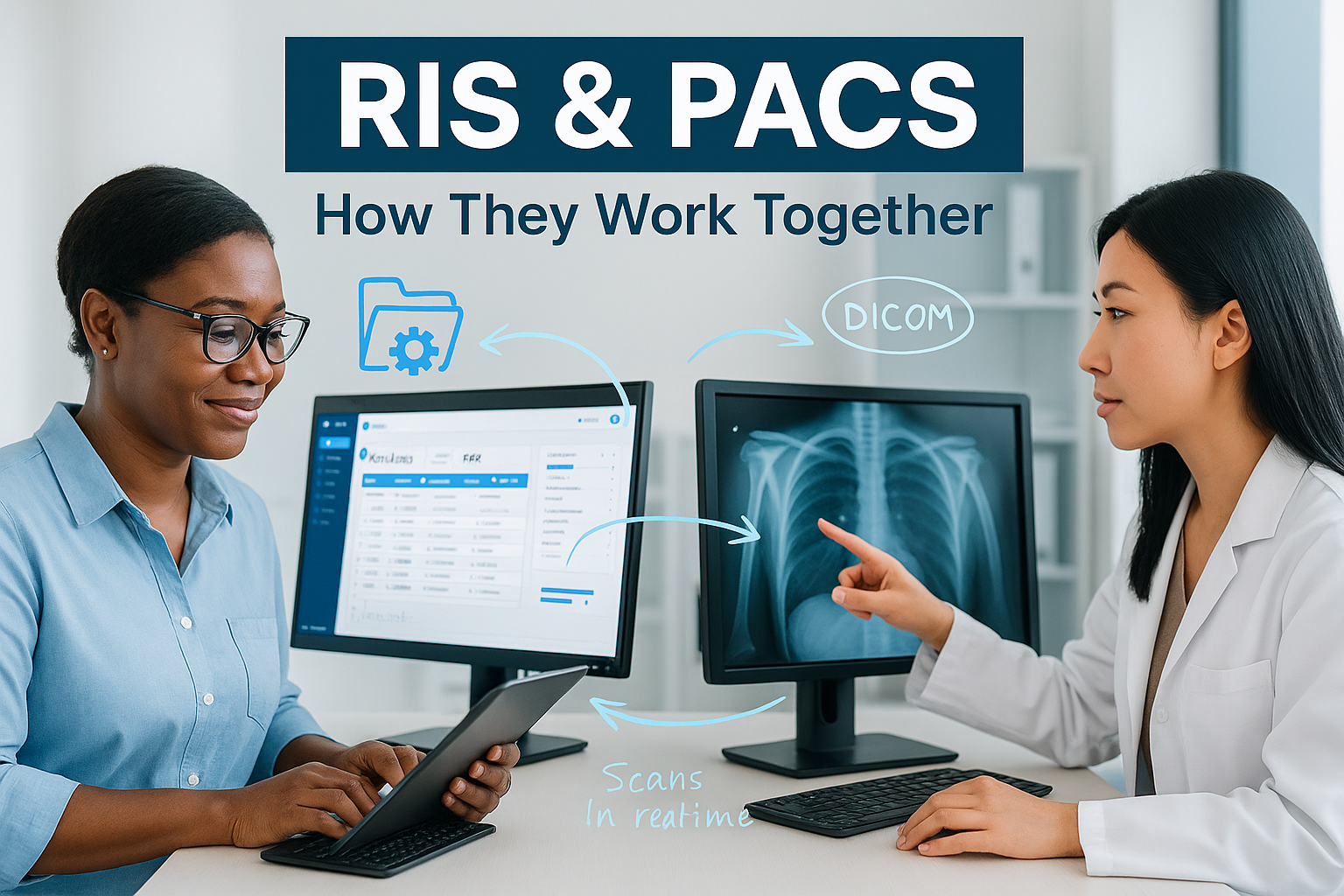RIS vs PACS: Your Complete Guide to Radiology Excellence
Master the systems that power modern medical imaging and boost your department's efficiency by 30%
⚡ Quick Fact: Integrated RIS-PACS systems can reduce operational costs by up to 30%
Introduction
◉ Key Insight: RIS and PACS are the backbone of modern radiology departments
In the rapidly evolving world of healthcare, medical imaging stands as a cornerstone of diagnostic excellence. The intricate dance of radiology, where precision meets patient care, relies heavily on advanced technological systems. Two of these paramount systems, the Radiology Information System (RIS) and the Picture Archiving and Communication System (PACS), are often the unsung heroes behind the scenes.
While they might sound like just more industry jargon, RIS and PACS play fundamental roles in streamlining processes, ensuring patient safety, and enhancing the quality of care.
For healthcare professionals, understanding the nuances of RIS and PACS is more than just a technical exercise—it's key to optimizing patient outcomes and operational efficiency. As the demand for quick and accurate medical imaging grows, so does the importance of these systems.
📚 In this comprehensive guide, we'll demystify RIS and PACS, highlight their differences, and illuminate their symbiotic relationship
RIS: Your Command Center for Radiology Excellence
A Radiology Information System (RIS) is specialized software designed to manage both administrative and clinical data in radiology departments. It acts as an integrated database and workflow management tool for healthcare providers specializing in radiology.
Primary Functionalities:
▸ Scheduling
Automates the booking, rescheduling, and tracking of appointments, optimizing the use of resources such as radiology equipment and personnel.
▸ Patient Tracking
Monitors the patient's entire journey within the radiology department, capturing all interactions, procedures, and statuses.
▸ Registration
Manages the initial entry of patient data into the system, including demographic information and medical history, which is crucial for personalized care and billing.
▸ Technologist Workflow
Streamlines the workflow for radiologic technologists by managing task assignments, equipment settings, and quality control measures.
▸ Results Distribution / Radiology Reporting
Facilitates the creation, storage, and distribution of radiology reports. It often includes dictation capabilities to assist radiologists in generating reports more efficiently.
Importance of RIS in Healthcare
In today's fast-paced medical environment, efficiency and accuracy are paramount. RIS offers both, wrapped in a package of digital brilliance. By centralizing patient data, streamlining administrative tasks, and providing robust reporting capabilities, RIS plays a pivotal role in improving patient outcomes and departmental efficiencies.
Moreover, with the increasing need for telehealth and remote consultations, RIS provides a seamless interface for healthcare professionals to access and share pertinent patient data, irrespective of geographical barriers.
🚀 Advancements in RIS Technology
As with many facets of healthcare, RIS is not static. Technological advancements, driven by the relentless pursuit of better patient care and operational efficiency, have continually refined RIS. From AI-powered scheduling tools to advanced analytics that provide insights into patient demographics and departmental workloads, the modern RIS is a far cry from its predecessors.
PACS: The Digital Heart of Medical Imaging
The Picture Archiving and Communication System, universally known as PACS, stands as the digital heart of medical imaging. While RIS manages the administrative side of radiology, PACS takes charge of the visual data, ensuring that medical images are safely stored, easily retrievable, and seamlessly shareable.
Core Functionalities:
◉ Storage
In the age of digital imaging, the sheer volume of visual data can be staggering. PACS offers a robust storage solution, ensuring that images are archived safely, retaining their quality over time.
◉ Retrieval
It's not just about storing; it's about accessing. With PACS, healthcare professionals can swiftly retrieve relevant images, aiding in timely diagnoses and treatments.
◉ Integration
One of PACS's standout features is its ability to integrate with other medical systems, ensuring a unified patient record and streamlining workflows.
💾 Role in Storing and Retrieving Images
Medical images are more than just pictures; they are pivotal diagnostic tools that can influence patient outcomes. PACS ensures that these images are not only stored with utmost care but are also available at the fingertips of healthcare professionals when needed. By leveraging advanced algorithms and digital infrastructure, PACS minimizes retrieval times, ensuring that crucial decisions aren't delayed.
🔗 Integration with Medical Systems
In the interconnected world of modern healthcare, isolated systems are a relic of the past. PACS exemplifies this by offering seamless integration capabilities. Whether it's syncing with a RIS to pull up a patient's historical details or interfacing with hospital's Electronic Health Record (EHR) and Electronic Medical Record systems, PACS fosters collaboration and enhances patient care.
Key Differences Between RIS and PACS
While both RIS and PACS are cornerstones of a modern radiology department, they serve distinct purposes and have unique functionalities. For healthcare professionals, understanding these differences is crucial for maximizing the utility of each system and ensuring seamless patient care.
⚡ Operational Focus
RIS: Administrative Excellence
Manages scheduling, registration, patient tracking, technologist workflow, and report distribution.
PACS: Image Management
Designed to store, retrieve, and share medical images for diagnosis and treatment.
👥 User Interaction
RIS Users
Administrative staff, technologists, and referring physicians for scheduling and reporting.
PACS Users
Radiologists and surgeons for viewing and analyzing medical images.
📊 Data Types
RIS Data
Alphanumeric data: patient demographics, appointments, billing, and clinical reports.
PACS Data
Digital medical images using DICOM standard from various modalities.
🔗 Integration Capabilities
RIS Integration
Central hub integrating with HIS for admin tasks, bridging healthcare systems.
PACS Integration
Clinical and DICOM-compliant, syncs with RIS, EHR, and dictation systems.
The Symbiotic Relationship Between RIS and PACS
✨ While RIS and PACS have distinct roles, their combined prowess is where the magic truly happens
The Collaborative Nature in a Radiology Department
Radiology, at its essence, is a blend of administrative precision and imaging excellence. While RIS manages the administrative intricacies, PACS ensures that the right image is available at the right time. Their collaboration ensures:
⏱️ Speed: Quick access to both patient details and their medical images, reducing wait times and potential errors.
🔄 Efficiency: A streamlined workflow where administrative and imaging data are in sync, leading to quicker diagnoses and treatments.
Benefits of Integrated RIS-PACS Systems
🚀 Seamless Workflows
With integrated systems, data redundancy is minimized, and processes are streamlined, leading to increased departmental efficiency.
❤️ Improved Patient Care
Having a unified system means fewer chances of miscommunication or data lapses, ensuring patients receive timely and accurate care.
💰 Reduced Operational Costs
An integrated RIS-PACS system can lead to savings by reducing the need for multiple interfaces and minimizing errors.
📈 Real-World Success Stories
Many leading healthcare institutions globally have experienced the transformative power of integrated RIS-PACS systems:
- Hospital A reported a 30% increase in radiology department efficiency after integrating their RIS and PACS.
- Clinic B noted a significant reduction in patient wait times and a marked improvement in patient satisfaction scores post-integration.
Considerations When Implementing or Upgrading RIS or PACS
As the healthcare industry continually evolves, so does the need to adapt and upgrade critical systems like RIS and PACS. Whether you're integrating these systems for the first time or looking to enhance existing infrastructure, several considerations can significantly influence the success of the endeavor.
🎯 Evaluating Your Healthcare Facility's Needs
✓ Assess Current Workflow: Understand the existing bottlenecks and efficiencies within your radiology department.
✓ Define Objectives: Outline what you aim to achieve with the new or upgraded system—whether it's increased efficiency, enhanced patient care, or streamlined administrative tasks.
💡 Understanding Technological Advancements
✓ Stay Updated: Regularly attend seminars, webinars, or conferences to stay abreast of the latest in RIS and PACS technology.
✓ Seek Expert Opinions: Collaborate with industry experts or consultants to understand which new features or advancements could benefit your facility.
🤝 Importance of Vendor Selection
✓ Reputation: Opt for vendors with a proven track record in RIS and PACS implementations.
✓ Support & Training: Ensure the vendor provides comprehensive training and post-implementation support.
✓ Customization: Every healthcare facility is unique. Choose a vendor that offers solutions tailored to your specific needs.
🔧 Integration & Compatibility
✓ System Compatibility: Confirm that the RIS and PACS systems are compatible with existing infrastructure, like EHRs or HIS.
✓ Data Migration: If you're upgrading, ensure a smooth data migration process with minimal disruptions.
The Future of RIS and PACS in Healthcare
Medical imaging, bolstered by systems like RIS and PACS, has always been at the forefront of healthcare innovation.
🤖 AI and Machine Learning Integration
- AI-powered diagnostic assistance and streamlined workflows
- Predictive analytics becoming standard features
- Machine learning optimizing scheduling and equipment maintenance
☁️ Cloud Integration
- Cloud-based RIS and PACS solutions for increased flexibility
- Enhanced scalability and remote access capabilities
- Improved disaster recovery and business continuity
🔐 Enhanced Security Protocols
- Advanced security measures to combat evolving cyber threats
- Blockchain integration for data integrity
- Zero-trust security architectures
🌟 Shaping the Future of Medical Imaging
The fusion of technological advancements with RIS and PACS will lead to interdisciplinary collaboration, global health networks, and sustainable practices. Expect a more interconnected global health ecosystem where patient data and medical images are easily accessible across borders, enhancing global health initiatives.
Conclusion
RIS and PACS are nothing short of revolutionary for the healthcare sector. They streamline processes, enhance patient care, and promise continuous evolution with cutting-edge technologies.
Navigating the intricate realms of RIS and PACS can, at first glance, seem daunting. Yet, as we've journeyed through their definitions, functionalities, differences, and synergies, it becomes evident that these systems are the backbone of modern radiology departments.
For healthcare professionals, understanding RIS and PACS is more than a mere academic exercise—it's about harnessing their power to optimize patient outcomes and elevate departmental efficiency. As we stand on the brink of a new era in healthcare technology, the marriage of RIS and PACS, enriched by AI, machine learning, and other advancements, promises a future that's both exciting and transformative.
🚀 To all the healthcare professionals, administrators, and curious minds who've journeyed with us through this exploration, we encourage you to delve deeper, stay updated, and be a part of this thrilling evolution. Here's to a brighter, more interconnected, and patient-centric future in medical imaging!
Ready to Transform Your Radiology Department?
Discover how AbbaDox's integrated RIS-PACS solutions can revolutionize your workflow
Schedule a Demo Today →






